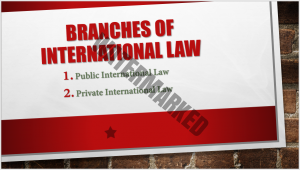There are two Branches of International law that is Public international law and Private international law.

1. Introduction:
Public international law and private international law are two branches of international law. generally, there is no distinction between public international law and private international law but it is very necessary that one should not confuse public international law and private international law.
2. Definitions of international law:
Oppenheim
International law is a body of customary and conventional rules, which are considered binding on civilized states in their relations with each other
Strake
It is a body of customary and conventional rules which are considered binding on civilized states in their relationships with each other and includes also functioning of international institutions and their relations with each other and states and their individuals in relation with states and international institutions.
3. Basis of international law:
There are two principal theories regarding the basis of international law.
(i) Theory of fundamental rights or natural law theory.
(ii) Consent theory or positivism.
I. Natural law theory:
Natural law theory is also known as the theory of fundamental rights. the follower of this theory believes that the basis of all laws is natural law. this theory believes that the basis of all laws is natural law. Therefore, this theory is traced back of the Greek civilization Grottoes rationalized natural law and applied it in international.
II. Consent theory:
According to consent theory international law consists of the rules which the states have consented to observe. the consent may be express or implied the exponent of consent theory is by kershoek.
4. Definition of public international law:
Oppenheim
“Public international is a body of customary and conventional rules, which are considered binding on civilized states in their relationships with each other.”
Schwarnzen Berger
According to Schwarnzen Berger “international law is a body of legal rules which apply between sovereign states and such entities which have been granted international legal personality.
5. Definition of private international law:
M. P Tandon:
“Private international law is a body of principles determining questions as to jurisdictions and questions as to the selection of appropriate law, in civil cases which present themselves for decision before a court of one state or country, but which involves a foreign element i. e. which effect foreign persons or foreign or transactions that have been entered in a foreign country or with respect of foreign system of law”
Pitt Cobbet
According to Pitt Cobbet:
“Private international law is the body of rules for determining questions as to the selection of appropriate law, in civil cases which present themselves for decision before the courts of one state or country, but which involve a foreign element i. e, which effect foreign persons or foreign things or transactions that had been entered into wholly or partly in a foreign country or with reference to some foreign system of law.”
6. The distinction between public international law and private international law:
I. As to consent:
Public international law based on the consent of the state.
Private international law is not based on the consent of the states.
II. As to object:
Public international law regulates relationship of states inter se and determines rights and duties of the subject states at the international sphere.
Private international law determines as to which law will apply two conflicting in a particular case having a foreign element.
III. As to conflict of laws:
Public international law does not involve in conflicts of laws.
Private international law involves in the conflicts of laws.
IV. As to nature:
Public international is same for all the states.
Private international may be different in various states.
V. As to sources:
Public international law has its sources in treaties, custom etc. etc.
Private international law has its sources in the legislation of the individual state to which the litigant belongs.
VI. As to application:
Public international law is applicable to criminal as well as civil cases.
Private international law is applicable to civil cases only, which present themselves for the accession of courts of the state.
VII. As to the subject:
Public international law deals with the states.
Private international law deals with individuals.
VIII. As to municipal law:
Public international law is not part of municipal law.
IX. As to jurisdiction:
Public international law does not involve determination on the question of determination.
Private international law determines court which will have jurisdiction to decide issue in question.
X. As to scope:
Public international law has a wider scope. it is of universal character.
Private international law has a lesser scope.
7. Conclusion:
To conclude it can be said that, public international law and private international law are branches of international law. public international law is known as conflict of laws. these are different from each another but in some exceptional cases, rules of private international law may become rules of public international law.
So, this was a brief article regarding the Branches of International law: Public and Private international law.
For more about International Law
Visit: https://www.seekergk.com/international-law/
or Home page





